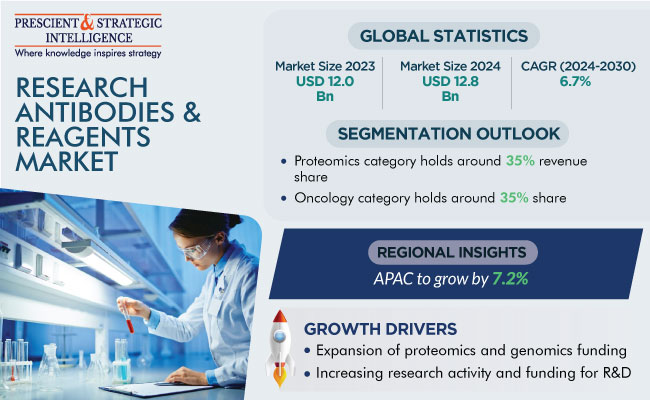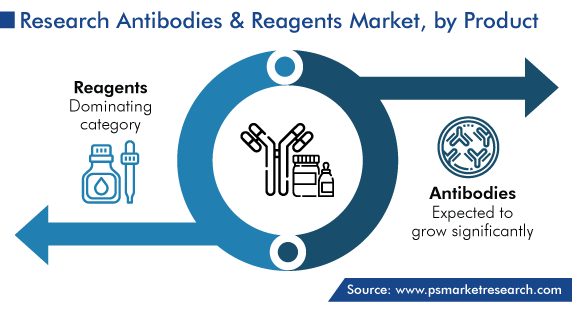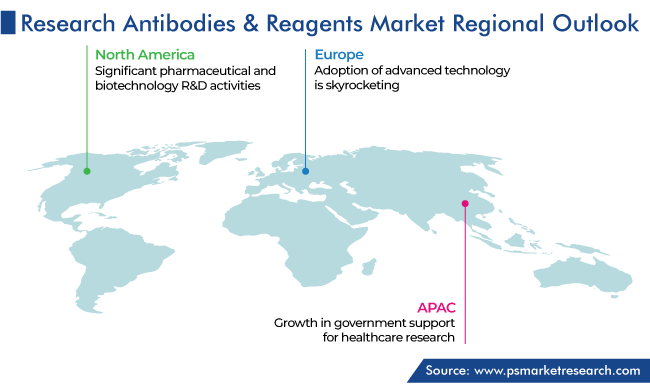Report Code: 12851 | Available Format: PDF | Pages: 330
Research Antibodies and Reagents Market Size and Share Report by Product (Reagents, Antibodies), Type (Primary, Secondary), Vertical (Oncology, Infectious Diseases, Immunology, Neurobiology, Stem Cells), Source (Mice, Rabbits), Form (Monoclonal, Polyclonal, Recombinant), Technology (Western Blotting, Flow Cytometry, ELISA, Immunohistochemistry, Immunofluorescence, Immunoprecipitation), Application (Proteomics, Drug Development, Genomics), End User (Pharmaceutical and Biotechnology Industries, Academic and Research Institutions, Contract Research Organizations) - Global Industry Demand Forecast to 2030
- Report Code: 12851
- Available Format: PDF
- Pages: 330
- Report Description
- Table of Contents
- Market Segmentation
- Request Free Sample
Market Overview
The global research antibodies and reagents market generated revenue of USD 12.0 billion in 2023, which is expected to witness a CAGR of 6.7% during the forecast period (2024–2030), reaching USD 18.7 billion by 2030. The market is driven by the expansion of proteomics and genomics funding, rise in the need for high-quality antibodies for research reproducibility, and increase in the R&D activities in the life sciences industry.
The industry is also driven by the growing demand for clinical diagnostics, new drugs, and carrier screening and the increasing prevalence of genetic disorders. In addition, the rapid technological advancement in pharmaceutical platforms, increasing initiatives and funding from government and private bodies for large-scale biotechnology projects, and the significant application of antibodies & reagents in pharmaceutical & biotechnology analyses lead to the expansion of the market.

Primarily, the strong R&D activities for the creation of new vaccination and treatment methods have significantly boosted the need for research antibodies. In addition, numerous government and private organizations are making significant efforts to raise funds for the creation of COVID-19 vaccines and treatments. For instance, in April 2020, Emergent BioSolutions Inc. received USD 14.5 million from the federal government to work on antibody therapy testing for COVID-19.
Additionally, antibodies are currently one of the most-important tools for research projects exploring the function of various proteins in cells. The prevalence of neurodegenerative diseases, such as Huntington’s disease, multiple sclerosis, and Parkinson’s disease, is boosting research aimed at their better understanding. Additionally, the growth of the geriatric population and the lack of effective treatments for chronic diseases have contributed to the rising need for novel antibodies to develop specialized medications, advanced pharmaceuticals, and safe and effective treatments.
Increasing Research Activity and Funding for R&D
The increasing research activities to develop new drugs, get them into trials, and have them approved drive the market. Furthermore, governments are investing in such activities due to the rising prevalence of infectious and chronic diseases, for finding effective treatments. As a result, life sciences research activities have broken several records in terms of funding, scientific advancements, as well as the quantity and variety of new medications that are available to patients all around the world. Further, the industry made several ground-breaking contributions during the COVID-19 pandemic in the form of therapeutics and vaccines, aided by the efficient usage of a wide variety of research antibodies & reagents.
Moreover, financing firms are showing interest in life science discoveries. For instance, in 2021, more than 2,000 research funding agreements with a combined value of USD 47 billion were closed. In addition, the 15 biggest pharmaceutical firms invested a record USD 133 billion in R&D in 2021, an increase of 44% from 2016.
Reagents Category Dominates Market
The reagents category dominated the product segment with a revenue share of around 60% in 2023, and it is expected to continue being the larger contributor over this decade. This can be attributed to the growth in the application of biosciences and biotechnology within the healthcare and pharmaceutical industries and the rise in pharmaceutical and biotechnical research for discovering new, more-effective drugs.
Furthermore, the media & sera subcategory holds the largest share in the reagents category. This subcategory is driven by the many advantages of these chemicals, such as easier purification and downstream processing, and their usage in all types of assays, cell cultures, and techniques. Researchers are also adopting them rapidly due to their lower risk of contamination with bacteria, fungi, and viruses and the ability to form reproducible formulations, which are needed for more-convincing and consistent research results.

Primary Antibodies Account for Larger Share
Primary antibodies contributed around 70% revenue in 2023, and this trend is expected to continue till 2030. This can be attributed to the wide range of utilities provided by such antibodies in the R&D space, as well as the growing accessibility of primary antibodies using rabbits, mice, goats, and other species as hosts. Additionally, the market is expected to expand in this category due to the widespread use of primary antibodies in routine laboratory procedures, including staining and imaging.
The secondary antibodies category is expected to register the higher CAGR during the projection time frame, as these antibodies are more convenient and cost-effective to develop. Moreover, the availability of ready-to-use conjugated antibodies, which can enhance product development efforts by assisting in the identification, grouping, and purification of selected antigens, is contributing to the rise in the demand for secondary research antibodies.
For instance, Thermo Fisher Scientific Inc. provides fluorescent dye-conjugated secondary antibodies, which make it easier to identify proteins in a variety of applications, such as immunohistochemistry, western blotting, and fluorescent cell imaging.
Oncology Category Holds Largest Share
By vertical, the oncology category accounted for the largest share of around 35%, in 2023, and it is further expected to maintain its dominance in the future, owing to the rise in the prevalence of cancer in key geographies. According to the American Cancer Society, in 2020, approximately 20 million new cases and 1 million cancer deaths were recorded globally. As a result, more research antibodies will be utilized in the development and assessment of novel diagnostic and therapeutic approaches for cancer in the years to come.
Furthermore, the stem cells category is predicted to experience tremendous growth as a result of a rise in stem cell research initiatives worldwide. The expansion is essentially credited to the increase in the use of stem cells for the treatment of numerous chronic illnesses, including diabetes, cancer, Alzheimer's, Parkinson's, rheumatoid arthritis, and renal and lung diseases. Additionally, antibodies are employed in stem cell research on disease modeling, developmental biology, drug screening, development of reprogramming procedures, and cell therapy.
| Report Attribute | Details |
Market Size in 2023 |
USD 12.0 Billion |
Market Size in 2024 |
USD 12.7 Billion |
Revenue Forecast in 2030 |
USD 18.7 Billion |
Growth Rate |
6.7% CAGR |
Historical Years |
2017-2023 |
Forecast Years |
2024-2030 |
Report Scope |
Market Trends, Drivers, and Restraints; Revenue Estimation and Forecast; Segmentation Analysis; Impact of COVID-19; Companies’ Strategic Developments; Market Share Analysis of Key Players; Company Profiling |
Segments Covered |
By Type; By Vertical; By Source; By Product; By Form; By Technology; By application; By end user; By Region |
Explore more about this report - Request free sample
Mice Category Holds Largest Market Portion
By source, the mice category holds the largest share owing to the high reproduction rate and smaller size of the antibodies and reagents created from mouse tissue. The anatomical, physiological, and genetic similarity between mouse and human antibodies, which strongly influences their adoption in R&D applications, is the most-important factor driving this category. Furthermore, mice have been predominantly used for the production of antibodies for ages.
Western Blotting Accounts for Largest Share
The western blotting category accounts for the largest share due to the widespread availability and adoption of this technique in healthcare R&D. The western blotting approach is frequently preferred over alternative technologies for applications involving the detection of significant protein entities, due to the improved accuracy it provides.
Furthermore, the flow cytometry category is expected to register the highest CAGR during the forecast time frame. The growth of this category is driven by the capacity of this technique to perform simultaneous multiparameter analysis on single cells within a heterogeneous mixture, thus offering a high throughput. Along with this, the technological advancements in flow cytometry and expanding oncology research efforts are driving the growth of this category.
North America Is Prime Revenue Contributor
Geographically, North America held the largest share, of around 55%, in 2023, and it is expected to grow at a robust CAGR during the review period, attributed to the significant pharmaceutical and biotechnology R&D activities. Moreover, the rising susceptibility of the people in the region to all kinds of diseases, presence of key healthcare businesses, and governments’ extensive support for the establishment of R&D centers boost the market. Additionally, the rapid integration of newly developed technologies and the increasing incidence of chronic diseases in the region collectively bolster the expansion of the market.
Furthermore, the North American market is expanding due to the increasing investments for the development of structure-based drug designs, growing research in the fields of genomics and proteomics, and surging focus of stakeholders on biotechnology research projects.

Moreover, the adoption of this technology is skyrocketing in Europe on account of the high cancer rate in the region. Europe accounts for 22.8% of the total cancer cases and 19.6% of the cancer deaths, although it represents merely 9.7% of the global population. Additionally, the expansion of the partnerships between European healthcare institutions and the research industry is responsible for the market expansion.
Top Providers of Research Antibodies & Reagents Are:
- Thermo Fisher Scientific Inc.
- Merck KGaA
- Abcam plc
- Becton, Dickinson and Company
- F. Hoffmann-La Roche Ltd.
- PerkinElmer Inc.
- Bio-Rad Laboratories Inc.
- Teva Pharmaceutical Industries Limited
- Eli Lily and Company
- Agilent Technologies Inc.
Market Breakdown
This report offers deep insights into the research antibodies and reagents market, with size estimation for 2017 to 2030, the major drivers, restraints, trends and opportunities, and competitor analysis.
Segment Analysis, By Product
- Reagents
- Media & sera
- Stains & dyes
- Fixatives
- Buffers
- Solvents
- Enzymes
- Probes
- Antibodies
Segment Analysis, By Type
- Primary
- Secondary
Segment Analysis, By Vertical
- Oncology
- Infectious Diseases
- Immunology
- Neurobiology
- Stem Cells
Segment Analysis, By Source
- Mice
- Rabbits
Segment Analysis, By Form
- Monoclonal
- Polyclonal
- Recombinant
Segment Analysis, By Technology
- Western Blotting
- Flow Cytometry
- Enzyme-Linked Immunosorbent Assay (ELISA)
- Immunohistochemistry
- Immunofluorescence
- Immunoprecipitation
Segment Analysis, By Application
- Proteomics
- Drug Development
- Genomics
Segment Analysis, By End User
- Pharmaceutical and Biotechnology Industries
- Academic and Research Institutions
- Contract Research Organizations
Region/Countries Reviewed for this Report
- North America
- U.S.
- Canada
- Europe
- Germany
- U.K.
- France
- Italy
- Spain
- Asia-Pacific
- Japan
- China
- India
- South Korea
- Australia
- Latin America
- Brazil
- Mexico
- Middle East and Africa
- Saudi Arabia
- South Africa
- U.A.E.
The 2023 revenue of the market for research antibodies & reagents is USD 12.0 billion.
The research antibodies & reagents industry is displaying a CAGR of 6.7%.
Protein-based therapeutics and personalized medicine offer opportunities in the market for research antibodies & reagents.
Reagents hold the larger research antibodies & reagents industry share.
The market for research antibodies & reagents is driven by the rising pharmaceutical and biotechnology research, especially on proteomics and genomics.
Mice are preferred in the research antibodies & reagents industry.
APAC is the fastest-growing regional market for research antibodies & reagents.
Want a report tailored exactly to your business strategy?
Request CustomizationWant an insight-rich discussion with the report author?
Speak to AnalystOur dedication to providing the most-accurate market information has earned us verification by Dun & Bradstreet (D&B). We strive for quality checking of the highest level to enable data-driven decision making for you
Our insights into the minutest levels of the markets, including the latest trends and competitive landscape, give you all the answers you need to take your business to new heights
With 24/7 research support, we ensure that the wheels of your business never stop turning. Don’t let time stand in your way. Get all your queries answered with a simple phone call or email, as and when required
We take a cautious approach to protecting your personal and confidential information. Trust is the strongest bond that connects us and our clients, and trust we build by complying with all international and domestic data protection and privacy laws